LAST UPDATED – 7/27/23 – Planning Your Trip
One of the most important aspects of planning any trip is logistics. Even the most well-made plans can fall apart if you don’t have the logistics of your trip covered. I told you about the mistakes I made when planning our trip to Switzerland a few years back but let me elaborate as they are great examples of how poor logistics can add a lot of unnecessary stress to your trip.
After starting to plan our trip, we narrowed down the cities that we would be visiting Zermatt, Interlaken, Grindelwald, Lauterbrunnen, and Lucerne. We would be coming up from Italy and had about a week to see all of these places. I know, not enough time. That was logistical mistake number one. I love pushing the envelope when it comes to fitting as much as I can into a trip but fitting five cities into five days was tight.
That issue was compounded by the next logistical mistake that I made. Instead of picking one or two central locations to use as hubs, and then traveling out from those locations daily to see what we wanted to see, I booked a different hotel each night in each one of those cities. More on the hotel in Grindelwald in a bit.
If you are familiar with the geography of Switzerland, the towns of Interlaken, Grindelwald, and Lauterbrunnen are all about a 30-45 minute train ride apart. It would have made a whole lot more sense, and been much easier, to book one hotel for 3 nights in one of those cities and then taken a train back and forth each day. Instead, we had to lug our baggage on trains from city-to-city and check-in and out of multiple hotels. Needless to say, it added a lot of unnecessary stress, and wasted time, to our trip.
To make matters even worse, the hotel that I booked in Grindelwald, which was absolutely beautiful, was only accessible by cable car or foot. And because cable cars need to be operated by humans (go figure), there was only a certain window in which you could get up to the hotel or back down to the city each day.
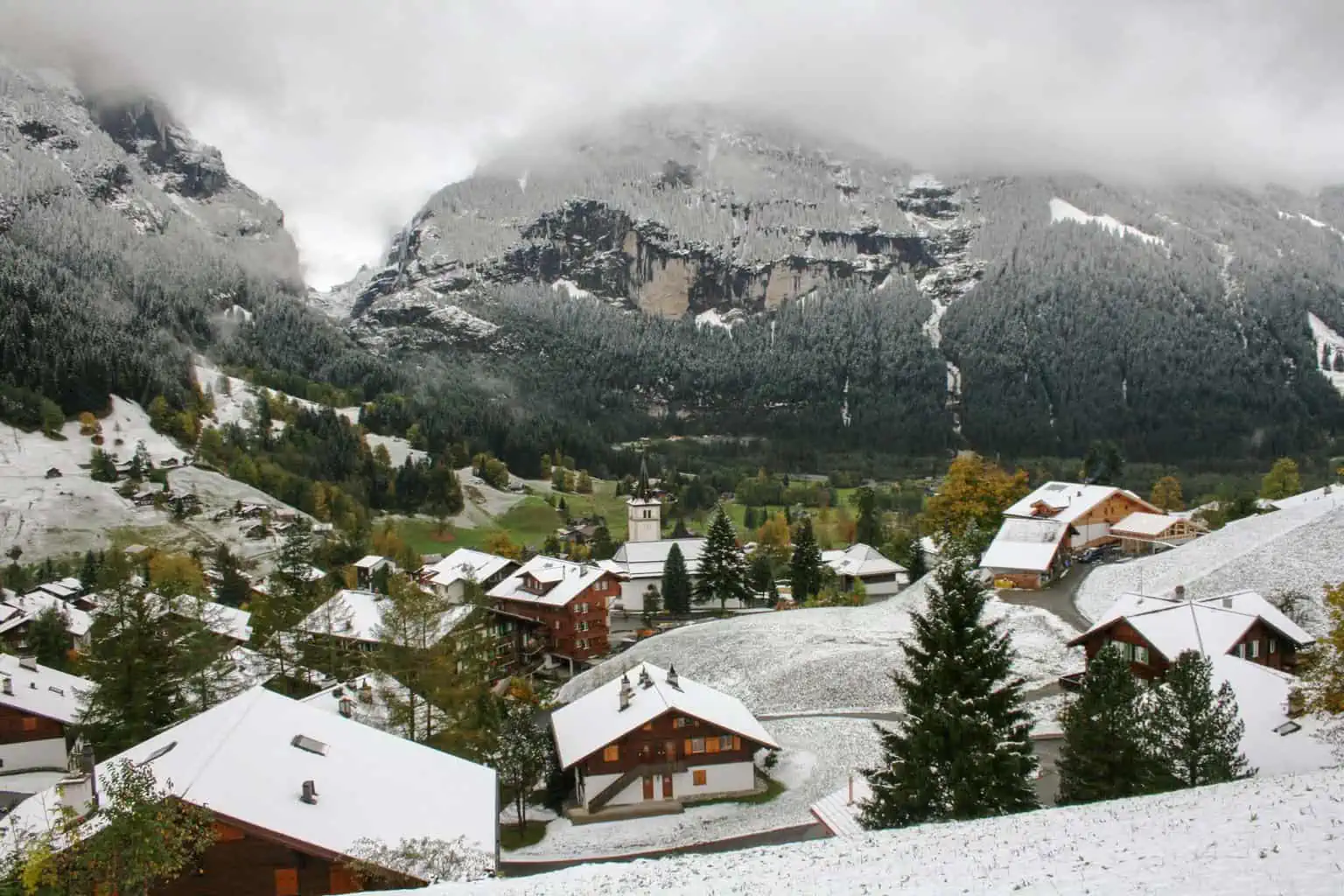
If I hadn’t booked hotels in multiple cities, and we weren’t so set on exploring much of the region, this would have been perfectly fine. The hotel was fabulous and the scenery was stunning. But we wanted to explore a lot of the region and didn’t want to be restricted on when we had to come and go from our hotel. I have no problem with walking, but lugging baggage up a mountain is a different story. Again, another logistical mistake.
I know by now I probably sound like a bumbling fool, and it is a little embarrassing to look back on this now and realize just how naïve about travel I was back then, but it was a great travel experience. It taught me some invaluable lessons. The most important of which is that you should never take shortcuts in your travel planning, especially with the logistics. Spend time up front because it can save you a world of frustration later.
In Part One of this article I talked to you about the W’s and H’s, and the 3W/3H approach to planning a trip. In that article, I discussed how important it was to start planning any trip with a simple assessment of what you want to see, and then determine where those places are.
| READ MORE: |
 |
| Deciding Where to Travel |
If you were following along with your own trip in mind, you should have a compiled list of all of the things your group would like to see, ranked in order of what your group would like to see the most, and a map with all of these places laid out on it. If you haven’t done that yet, I suggest you go back and do that before reading this article any further. It will be awfully difficult to start planning the “how”, or the logistics, of your trip if you don’t yet know what you want to see and where those things are.
With that said, let’s start talking logistics.
The “How”
Now that you know where the places you want to see reside, the next step is to work out the logistics of how you are going to get to these places. If everything you want to see is in one place, you’re all set. Just find a hotel that you like, book it, and apart from figuring out how to get from the airport to your hotel and back, you are practically set.
However, more than likely the things that you want to see are in different parts of the city, the country, or may even be in completely different countries. In those cases, logistics become extremely important.
Determine the Proximity of Locations to One Another
The first thing I typically do when working out the logistics of my trips is taking the map, or maps, that I created in determining the “where” and group the locations by proximity to one another. To do this I create semi-transparent squares and use the map’s legend to make sure I know what size area they represent. For instance, in the map below I created semi-transparent squares that have sides that are twice the length of the legend, or roughly 105km x 105km (which converts to roughly 65 miles x 65 miles).
I then took those squares and tried to fit as many of the pins on my map representing locations we need to visit into as few squares as I could. As you can see below, three of the squares I placed on the map have multiple locations within them, while the other three squares are limited to just one location per square.
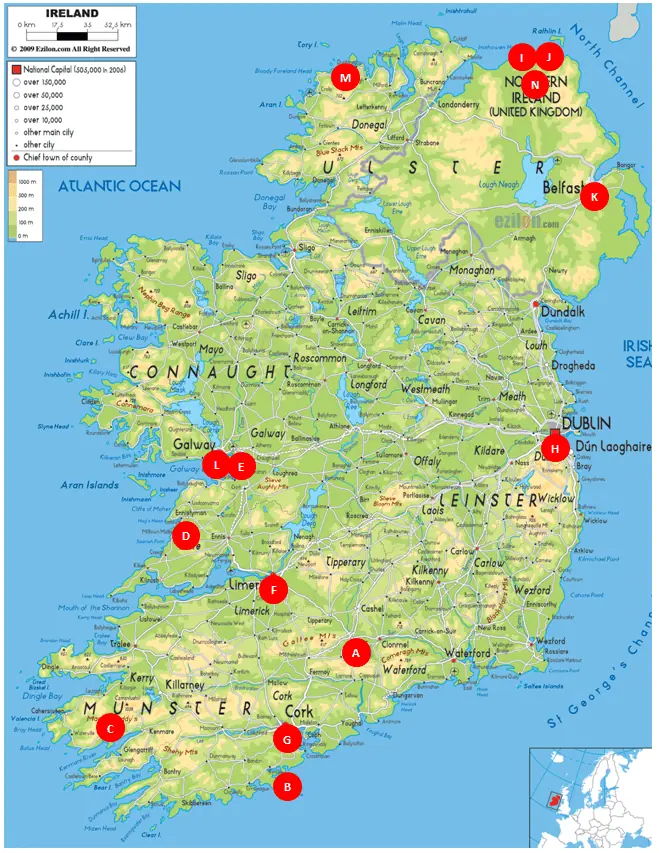
| Cahir Castle | |
| Old Head Golf | |
| Ring of Kerry | |
| Cliffs of Moher | |
| Aran Islands | |
| Dromoland Castle | |
| Blarney Castle | |
| Dublin | |
| Giant’s Causeway | |
| Carrick-a-Rede Bridge | |
| Belfast | |
| Galway Cathedral | |
| Slieve League Cliffs | |
| Dark Hedges |
This is a great way to start to conceptualize which locations are close to each other, and which might be off by themselves and more difficult to get to logistically. This will help me start to lay out a schedule by giving me some insight into where it might make the most sense to stay.
You are essentially trying to pinpoint locations that you can use as hubs to minimize the number of different hotels you will need to book, so don’t make the size of the squares too large. It will do you no good to make squares that are 400 miles x 400 miles as it is unlikely you are going to want to travel 200-400 miles each way in a day to see something.
Now, distance is only one factor, as there may be circumstances where two places you want to see are only a short distance between each other, but still take an excessive amount of time to travel between. That said, starting with the proximity in distance is a good starting point. You can always make adjustments later.
Looking at the map above, Dublin, the Ring of Kerry, and the Slieve Leauge Cliffs are all off on their own. Unless there are multiple attractions we want to see in those locations, this will make these locations more difficult to justify visiting (depending on the time you want to spend on your trip). It may be too difficult to justify traveling the distance it would require just to see one attraction.
This is where the list, with rankings, that you and your travel companions made comes in handy. If the attraction at one of the locations off by themselves is highly ranked, it may be worth the effort to get there. On the other hand, if the attraction is very lowly ranked, it may be more worthwhile to cross that location off your list.
In my example, the Ring of Kerry is the top-rated attraction on our list, while both Dublin and the Slieve League Cliffs were both near the bottom. This tells me that the Ring of Kerry would probably be worth the effort to work in, while the Slieve League Cliffs and Dublin may not be worth the extra effort to get to.
Because of this, I will keep the Ring of Kerry on the list, but cross off the Slieve League Cliffs. I can always re-add it later if I find some extra time. Considering the fact that it is highly likely that whatever flight we take to Ireland will arrive in Dublin, I will put a question mark by that for now, but leave it on the list.
Keep in mind, I have done the same thing with my maps of Scotland and London but haven’t posted those maps so that I can keep the illustration as simplified as possible.
Determine Mode of Transportation
The next step in the “how” process is to determine what mode of transportation you will be using to get from region to region, and location to location. This will assist you in determining which cities you will use as hubs, or base camps if you will, in which to explore the different regions (areas where your locations are concentrated). In turn, this will assist you in determining where you should book your hotels.
There are essentially four main modes of transportation to get you from region to region, and from place to place. Each has its pros, and each has its cons. Those modes of transportation are as follows:
- Renting a car
- Taking a train
- Riding a Bus
- Flying
Taking a taxi is an option to get you around a city or small region, but they can be awfully expensive, especially for long trips. For that reason, I left taxis off my list, but they shouldn’t be ignored as they can be a good option in some circumstances. Here is some advice I have found or can give on using each of these modes of transportation.
Renting a Car
Renting a car is probably the most convenient mode of transportation you can choose, as cars afford you the flexibility of coming and going as you like. However, renting a car can also be the most expensive method of transportation you can choose (yes, even more than flying in some cases).
Renting a Car in the United States
If you are traveling state-side, renting a car at your location is probably your best option for a number of reasons. First off, it will be relatively affordable. The average costs to rent a car in the USA are listed below:
- Economy: $45 to $65
- Intermediate: $50 to $70
- Standard: $55 to $75
- Luxury: $80 to $100
Forbes has some great advice on saving on car rentals in their article, Where It Costs The Most To Rent A Car (And How To Always Pay Less). It’s definitely worth the read.
If you are traveling overseas, the cost of renting a car will likely be higher than it is state-side when you factor in gas prices and all of the different fees. For those reasons, and others, renting a car may not be the cheapest or most convenient way to travel abroad.
Renting a Car in Europe (or I should say “hiring a car”)
The UK Telegraph does an excellent job of laying out the cost of renting a car in the different destination countries in Europe. As you can see, when factoring in potential other costs (the Excess Payable column), the cost to rent a car in Europe can be much more than you are used to paying in the US.
RickSteves.com also does an excellent job of laying out some tips to control the Rental Car Costs in Europe. You will absolutely want to read this article if you decide that renting a car is the way to go.
I typically budget $250-275 a day for a car rental in Europe. That includes the rental cost, plus taxes, insurance (I always purchase insurance out of the country), fees, gas, tolls, parking, etc.. Which is why I tend to look at public transportation as my first option when planning the logistics for my trips.
Renting a Car in Asia
Looking to rent a car in Asia? I haven’t traveled to Asia yet, but there is a lot of great advice out there that may help you. Justlanded.com has some helpful advice on what you will need to make a car reservation in China, and what you will need to pick up your rental car, as well as some other helpful advice. And here are some other useful tips from China Service Mall on what to be aware of when renting a car in China.
According to Japan-guide.com, renting a car to explore Japan is preferable because public transportation can be both infrequent and inconvenient. However, if you plan to rent a car in Japan, make sure you pick up an international driving permit before you leave home because they are not issued in Japan.
They also have a lot of useful information about locating a rental car company in Japan and some tips about rental car pricing, should you decide that renting a car is the option for you.
If you are planning to travel somewhere else in Asia, or to a destination in South America, Africa, or somewhere else wonderful in this world, make sure you do your research on car rentals and driving regulations before you commit to renting a car. In addition to pricing, here are some other pieces of information you should research.
- Do you need an international driving license?
- Do they sell international driving licenses locally, or should you obtain one before leaving?
- Is purchasing insurance required or recommended?
- Are there any driving laws that you are unaccustomed to?
- What do you need to reserve a car?
- What do you need to pick up a car?
- What rental car companies are available?
- What rental car companies are recommended?
- Are there any additional fees that you may be subject to?
- What is the cost of gasoline?
- How accessible are the roads to the locations you wish to visit?
- How is the traffic in the locations you wish to visit?
- Will you have parking available at the hotels you plan to stay at?
All of these factors can influence whether renting a car is the right option for your trip. After all, the last thing in the world you want is a rental car reservation, but no international driving license and no way to get one.
Taking a Train
If you are planning to travel in the US, then using public transportation (such as the subway) in some of our nation’s largest cities might make a lot of sense. That said, if you are planning to travel extensively across the country on a long road trip, it probably won’t be your cheapest or most convenient option.
However, if you are traveling overseas, taking a train may be more convenient and economical than renting a car.
Before deciding to use trains to travel between your locations, it will be important to take several factors into account.
- Will trains get you to all of your destinations?
- How frequently do trains run to your destinations?
- What is the cost of a rail pass where you are traveling?
- Do you have to purchase reservations on top of the cost of your rail pass where you are traveling?
The first factor to consider is arguably the most important. If trains do not service the locations you wish to visit, it will be awfully difficult to use trains to travel there. When we visited Spain last year, we wanted to check out Gibraltar. The problem was, there wasn’t train transportation to Gibraltar. We could have taken a train to the nearby town of Algeciras and then walked or taken a bus a few miles to Gibraltar, but the trains ran very infrequently to that town from where we were planning to stay and the hassle was more than it was worth. We ended up renting a car for that day to get to Gibraltar.
That brings me to the next question you need to answer. How often do trains service the locations you wish to visit? If trains arrive and depart from a location infrequently, it can make it difficult to use trains to travel to that location. For example, we wanted to visit the town of Ronda while in Spain. We could have taken a train to Ronda, but trains to and from the town of Ronda ran very infrequently. If we would have taken a train and arrived late morning, we would have had to get on another train to get back to where we were staying early that same afternoon. This didn’t make train travel to Ronda very convenient, so we ended up using a rental car to travel to Ronda as well.
Taking Trains in Europe
On top of the train schedules that are available on the Eurorail website, there is also a really cool app available that can make investigating possible rail travel in Europe a breeze. The name of the app is Train and Bus, and I included a screenshot preview of the app below. Just enter the name of a departure city, select a departure time early in the morning on any given date, and then try a number of different destination cities to see how often trains service the city you are investigating.
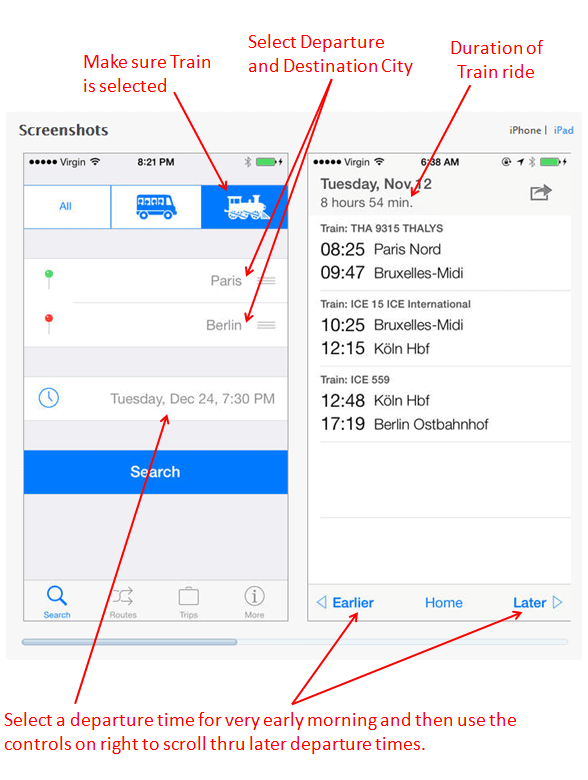
If you do decide that train travel is the right choice for your European vacation, you will want to start exploring your options for purchasing tickets. Here are the costs of some of the different Eurorail passes that you can purchase, depending on your needs (Prices are for 1st Class and Family assumes 2 adults and 2 children).
Note: You can find some help on how to choose the right pass on Eurorail’s website.
Choosing the Right Pass
- Explore up to 28 European countries by train.
- Free delivery in the U.S.A, Australia, Brazil and more countries. Plus, they can deliver your pass to a European address
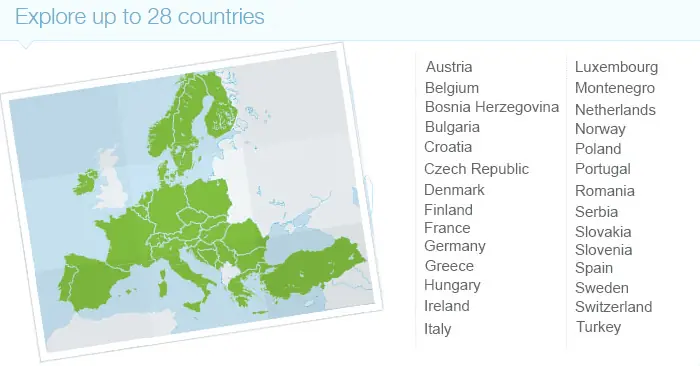
| Duration | Youth (18-25) | Adult (Over 26) | Family |
| 5 days within 1 month | $424.00 | $528.00 | $900.00 |
| 7 days within 1 month | $516.00 | $643.00 | $1,096.00 |
| 10 days within 2 months | $636.00 | $793.00 | $1,352.00 |
| 15 days within 2 months | $833.00 | $1,039.00 | $1,770.00 |
| 15 days continuous | $541.00 | $673.00 | $1,148.00 |
| 22 days continuous | $696.00 | $868.00 | $1,478.00 |
| 1 month continuous | $854.00 | $1,065.00 | $1,814.00 |
| 2 months continuous | $1,203.00 | $1,501.00 | $2,554.00 |
| 3 months continuous | $1,482.00 | $1,851.00 | $3,150.00 |
The Eurail Select Pass lets you discover 2, 3, or 4 bordering countries of your choice, including popular destinations like France, Spain, Italy and Germany.
- Take your pick from 27 European countries.
- Free delivery in the U.S.A, Australia, Brazil and more countries. Plus, they can deliver your pass to a European address.
- Use the map below to select the countries you want to visit.
- Prices will vary depending on which countries you choose and how many.
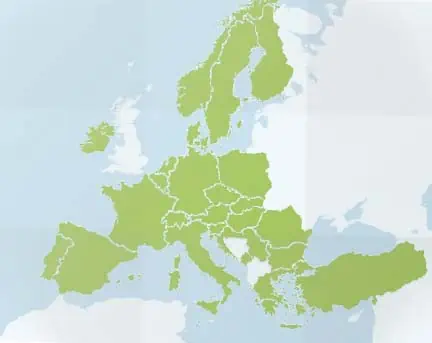
- Select one country that you are going to travel to.
- There are 21 different passes to choose from.
- Information on a Germany rail pass can be found Here.
- Prices are listed below.
| Country | Price | Country | Price |
| Austria | $150.00 | Italy | $150.00 |
| Benelux | $150.00 | Norway | $174.00 |
| Bulgaria | $94.00 | Poland | $69.00 |
| Croatia | $94.00 | Portugal | $94.00 |
| Czech Republic | $94.00 | Romania | $69.00 |
| Denmark | $126.00 | Scandinavia | $202.00 |
| Finland | $150.00 | Slovakia | $126.00 |
| Greece | $94.00 | Slovenia | $69.00 |
| Greek Islands | $184.00 | Spain | $174.00 |
| Hungary | $94.00 | Sweden | $174.00 |
| Ireland | $150.00 |
Are Reservations Required?
You are also going to want to do some research on whether or not reservations are required on top of the rail pass that you purchase. When we were in Switzerland, our rail pass covered us for most of the train trips that we had to take. We could make a free reservation to ensure that we had a seat on a train, but we didn’t need to pay an extra fee to make the reservation, nor was a reservation required.
In fact, it also covered any boat, bus, and even gondola ride that we wanted to take in the country. Switzerland’s rail pass is absolutely fantastic! However, when we traveled in Italy and Spain, reservations were required on most of the train trips that we took, and it cost a fee to book our reservations.
This may play a factor in whether or not train travel is the most affordable option for you. And even if it is the most affordable option, it may impact whether or not you purchase a train pass or just purchase your train tickets individually. If you will need to take a lot of really long train rides than a rail pass will probably be worthwhile as it will cost a considerable amount (as much as $200-$300) per ticket for some routes.
The cost to book a reservation is considerably less (roughly $10-$30 per reservation in most cases). However, if you are only planning to take very short train rides, then the cost of a ticket may be fairly close to the cost of a reservation, or at least low enough where it will be cheaper to buy all of your tickets without a rail pass instead of rail passes and reservations.
Example – Our Trip to Spain
For instance, when we were planning our trip to Spain we took a look at how much it would cost to travel by train to the following destinations:
- Barcelona to Valencia
- Valencia to Sevilla
- Sevilla to Cordoba
- Sevilla to Madrid
- Madrid to Toledo
- Madrid to Segovia
- Madrid to Zaragosa
While the cost to purchase a train ticket without a rail pass from Madrid to Toledo ($16), Madrid to Segovia ($30), Madrid to Zaragosa ($67), and Barcelona to Valencia ($67) were relatively cheap, the cost to purchase a ticket from Valencia to Sevilla ($114), and Sevilla to Madrid ($106) were considerably more expensive.
In our case, it cost less to purchase a rail pass with reservations than it would have been to purchase each of our train tickets without a rail pass. Though like I said, this is not always the case, so do your research.
I would suggest using RailEurope’s website to look up the cost of purchasing all of the train tickets you would need to purchase, then compare that to the cost of purchasing a rail pass and any reservations that might be required. Whichever option is lower would be your best option.
In regard to purchasing tickets or reservations in advance, please keep in mind that there is flexibility in switching some tickets if you want to take an earlier or later train once you get there, but you will need to show up at the train station well in advance. If you show up a half-hour before your train is set to leave, you will probably be out of luck.
Only Purchase Tickets\Reservations for Long Train Rides
For that reason, I would suggest that you only purchase the tickets or reservations for the long train rides between hub cities. In other words, make sure you are guaranteed to get to your next hotel on time. I would wait to purchase the tickets or reservations for the train rides you will be taking from your hub cities to other locations until you get there. This will give you more flexibility should you want to change your plans on the fly. If you are nervous about trains selling out, I would give Rail Europe a call and get their advice on specific trains you plan to take.
They have a 1-800 number here in the US and have been very helpful in my previous experiences working with them.
Need help? Rail Europe offers live help 5 days a week: Monday – Friday, 9:00am to 7:30pm Eastern Time. Call 1-800-622-8600 in the USA, 1-800-361-RAIL (7245) in Canada and 01-800-112-6680 in Mexico.
We also have a dedicated staff to assist with Group Travel of 10 or more travelers.
Rail Europe, Inc.
44 South Broadway
White Plains, NY 10601
Taking Trains Elsewhere
If you are planning on traveling to Asia, South America, Africa, or some other fabulous place in this world, I don’t have nearly the experience with train travel in those places as I do in Europe, so I have less advice I can give you. However, just like traveling by train in Europe, I would make sure you research the following information:
- Do trains service the locations you wish to travel to?
- How frequently do trains service those locations?
- Are there rail passes available?
- What options are available for rail passes, and what benefits do they give you?
- How much do rail passes cost?
- Are there different classes of tickets for the trains you want to take? (First class is usually more expensive than Second class)
- Do you need a reservation even with a rail pass?
- Do you have to purchase reservations, and how much do they cost?
- If rail passes aren’t available, how much will it cost to purchase all of the train tickets you will need?
- Is it cheaper to buy a rail pass and make reservations or to purchase your tickets without a rail pass?
- Is it advisable to purchase your tickets or reservations well in advance?
- Is there any flexibility in exchanging your rail tickets for an earlier or later train?
- What are the rules for exchanging your rail tickets? Are there fees?
- Are there sleeper compartments on the trains?
- Do they serve food and beverages on the trains?
- Where is luggage stored on the trains, and is it secure?
Riding a Bus
Another option that you have to travel between one location you would like to see, and another is by bus. Although this is arguably my least favorite mode of transportation, as it combines all of the annoying stops with the slow travel speed of car travel, in some locations it can be the most accessible and even most convenient way to travel.
As Leaveyourdailyhell.com points out, in some areas of the world (in this case South America), bus travel may be your best bet.
I am guessing that in more areas than I am aware of travel by bus is not only the most accessible and affordable mode of transportation but also the most comfortable. Many bus companies in countries throughout the world offer sleeping arrangements and even meals as part of their service. Factor in accommodations and meals you would have had to otherwise buy if you took alternative transportation, and this can further reduce your travel costs.
In addition, depending on what you are traveling to see, some of the roads that you would have to take if you drove might be quite dangerous. Would you want to operate a car on the so-called “death road” in Bolivia (pictured below)? Me neither.

On top of the driving conditions of the roads, you would have to travel, there are other factors that may influence your choice of transportation. One set of often-overlooked factors are the driving regulations in the country you are traveling to. Those regulations might make it difficult for you to rent a car.
Countries that Honor International Driving Permits
The map below illustrates which countries honor international driving permits, and which do not. If the country you are traveling to does not honor international driving permits than you may or may not be able to operate a motor vehicle in that country. It all depends on the driving regulations in that country. So do your research in advance. Another reason why public transportation, like riding a bus, might be your best bet.
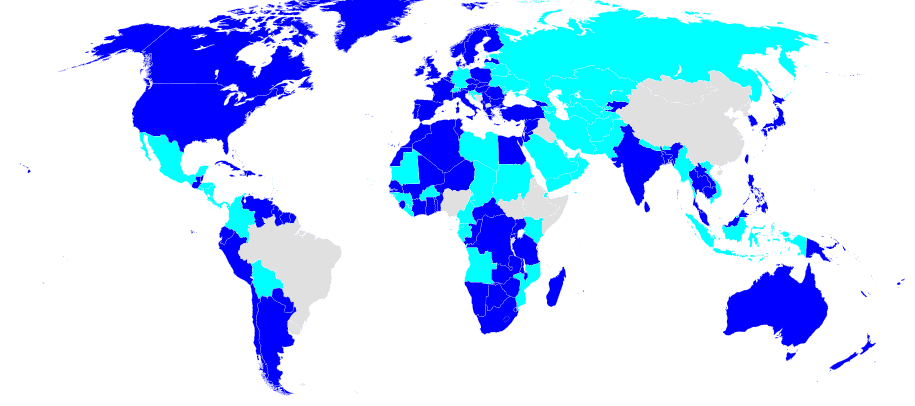

Some of the things you will want to research when determining whether bus travel is the best option for your trip are the following:
- What is needed to purchase a bus ticket?
- What is the cost of a ticket?
- Is it recommended to purchase tickets for your bus trips in advance?
- What are the durations of the bus trips you will need to take?
- What is the likelihood of cancellations or delays?
- What is included with your ticket (meals, sleeping quarters, etc..)?
- How often do the buses run?
- Is there storage space for luggage on the buses? Are those storage spaces secure?
- Is there a high frequency of theft or crime on the buses?
Flying
I think air travel is probably the most often over-looked method of travel for people once they reach their original destination. As Americans, I think it is engrained in us that once you fly to a destination, the next step is to rent a car and start exploring. The problem with driving, as I touched on earlier, is that it can take a really long time to get from one location to another (even if the distance isn’t that great). The same can be said for train travel in certain circumstances. The high-speed trains in Europe are amazing, but that type of efficiency isn’t matched all over the world. In some countries, a long train ride can be an all-day, and even all night, affair.
Besides, in some cases, flying might just be the cheapest option.
For instance, when researching transportation for my upcoming trip to Ireland, Scotland, and London, I looked at different modes of transportation between Dublin, Edinburgh, and London. In my case, there were no train options available between Dublin and Edinburgh, and the train ride from Edinburgh to London had a duration of roughly 4 hours and cost $114. When I looked at airfare between Dublin and Edinburgh (1 hour and 15 minutes flight for $83) and Edinburgh and London (1 hour and 35-minute flight for $85), flying made a whole lot more sense.
So if you need to travel a great distance during your trip, from one city or country to another, my advice to you is to look into the option of flying before booking any other transportation options. While in some regions of the world (like South America) it may not be worthwhile to fly because of price and/or schedule, in other regions of the world you may be shocked at just how affordable flying can be.
However, before you book a flight, make sure you do research on the airlines you plan to use. It will really ruin your trip if you book a flight from Dublin to Edinburgh and then get to the airport only to find out your flight has been significantly delayed or canceled.
A website that I commonly use to research the on-time\cancellation history of flights before I book them is Flightstats.com. As you can see below, I did some research on the on-time\cancellation history of Aer Lingus flights from Dublin to Edinburgh and got some pretty valuable information.
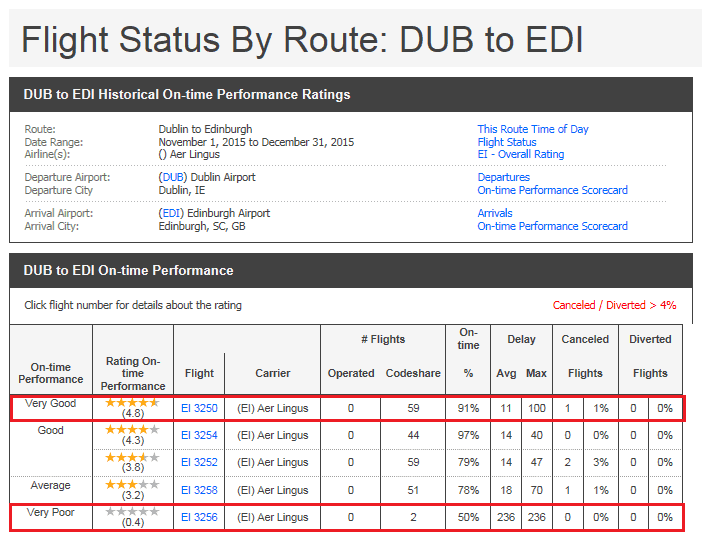
As you can see in this example, flight EL 3250 has an on-time history of 91%, which is pretty good. On the other hand, flight EL 3256 only has an on-time history of 50%, which is rated as “very poor”. If I am going to book a flight from Dublin to Edinburgh, I am going to want to avoid flight EL 3256 or choose a different airline all together if none of the results for the airline are satisfactory. Paying a little more for a flight is a whole lot better than spending a large chunk of your vacation in an airport waiting on a delayed flight.
If you aren’t seeing any airfare options within your budget but have some time before you need to lock in your transportation, you can always monitor the airfare prices to see if prices come down. A wonderful app that I like to use to do this work for me is Hopper (I included a screenshot below).
Enter your departure and arrival destinations, as well as your travel dates, and Hopper will give you a visual representation of which days are more expensive to fly to your destination and which days are the cheapest. This information can save you big. Hopper also lets you know when it anticipates prices to be lowest and will monitor your search and alert you if prices drop.
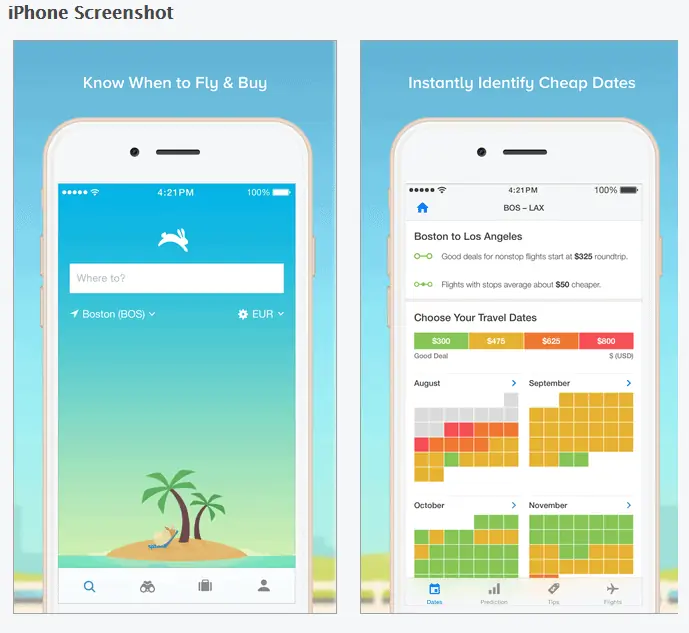
Picking Your Hubs
After you have had a chance to research the transportation options where you are traveling, you can start to think about which cities you will use as your hubs. That will allow you to start looking for and reserving hotels.
A tool that I have found very useful in helping me determine which cities to pick as my hubs are timetables. I like to create timetables for the various forms of transportation I am thinking about using on the trip and then using those tables to determine whether a certain city or another makes the most sense to use as a hub and what type of transportation I want to use. Let me use our trip to Spain last year as an example.
When determining which cities would be best to use as hubs, and how many hubs I would need, I created this timetable to show how long it would take to get from one city we were planning on visiting to another city by train. After all, you don’t want to be spending half your vacation on trains, so it is important to make sure travel times aren’t too long. I used conditional formatting in Excel to highlight which times are short (yellow), which times are long (red), and everything in between. At the bottom of the columns, you will find the average duration for all train rides from the city to the other destinations on my list.

I also created a separate table to show how many trains run between the different cities every day. This is also important because you don’t want to be limited in how long you can visit various cities because you have to catch an early train back to your hotel. Again, I used conditional formatting in Excel to highlight which cities have the most train service (yellow), which have the least (red), and everything in between. At the bottom of the columns, you will find the average number of trains that service that city from the other destinations on my list.

With all this information in mind, let’s start with the cities that would not make good hubs. As you can see from this chart, Gibraltar would make a horrible hub if I wanted to use Spain’s train system to get around as there is no train service to Gibraltar. Likewise, the city of Ronda would be a horrible hub as the frequency that trains service the town is small and the travel times to and from Ronda from our other destinations are long.
On the other hand, Madrid would be an absolutely fantastic hub. There is plenty of service from Madrid to many of the other cities we wanted to see, and the travel time from Madrid to these cities is fairly short. Madrid would make the hub list for sure.
Summary
Got all that? Just kidding, I know I threw a whole lot of information at you. The important thing to take away from this article is that the logistics you plan for your trip play a big part in how enjoyable your trip will be. In other words, the “how” is just as important as the “what” and “where”. After all, if you can’t get to what you want to see, how are you supposed to enjoy it?
In this article, I talked about the advantage of picking “hub” locations if your trip is going to include stops in multiple cities, regions, or countries. Not only will it save you the hassle of having to lug your bags around as much, but it will also save you time. It is time that can be better spent enjoying your vacation.
I also talked about the different modes of transportation that you can choose to get from place to place. They all have their advantages and disadvantages, and these pros and cons can differ greatly depending on where you travel. So please, make sure you do your research before you start making reservations.
At this point in your planning, you should have a pretty good feeling about what cities you want to use as your hubs, and which places you can reasonably visit from those hub cities. In Part III of this article, we will start to discuss the process of putting together an itinerary for your trip. This will give you a good idea of “how long” your trip will need to be to see everything on your list, “when” you will want to go, and “how much” that will cost.
Even if you need to go back and make adjustments to your trip, you will be well prepared to do that. You will know what everyone in your group wants to see, and how badly they want to see it. Therefore, you’ll know what your group won’t mind cutting out, and what they can’t live without seeing.
And even if you need to cut some things out of your trip to save time or money, you’ll know that you didn’t overlook some transportation logistics that could have saved you either. You will have researched all of your transportation options and will be prepared to make any adjustments as you start to lay out your timeline.
So, until next time, safe travels!
Don’t Forget to Subscribe to My Adventures!

Let Me Help You Save On Your Next Adventure!





Leave a Reply